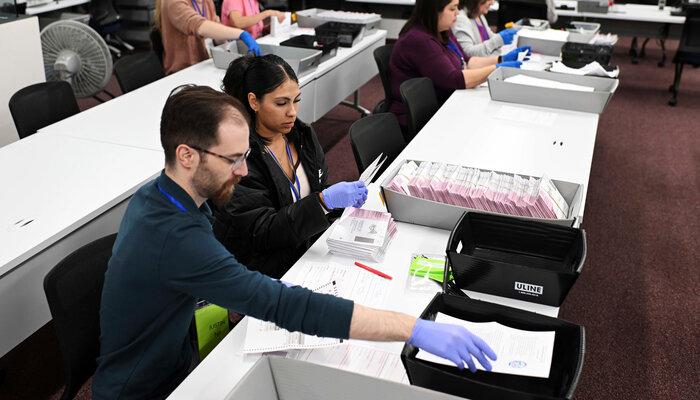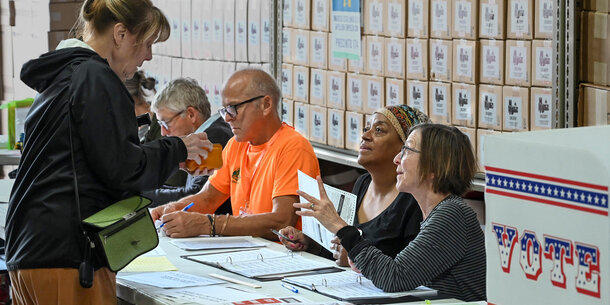Election results are never final on Election Day. As our recently updated Roadmap to the Official Count details, election officials follow a rigorous counting process, checking and rechecking all available information until they are confident that every eligible ballot has been counted and included in the final vote total. This process takes time, and the election workers who count votes must follow rules set by state law.
Since 2020, when vote counts slowed in many states due to large increases in mail voting and operational constraints necessitated by public health measures, some states updated their laws to enable election officials to count votes and release results faster. Most notably, Michigan now allows election workers to begin processing and tabulating mail ballots before Election Day.
Processing typically involves verifying the voter’s information and eligibility on the mail ballot envelope, opening the envelope, and removing the ballot so it is ready to be tabulated by a voting machine. This time-intensive process significantly slows down the pace at which election workers can count mail ballots, which is why 43 states allow election workers to begin this process before Election Day. With this change, Michigan officials will be able to release results faster than they could four years ago.
Other states refused to change rules that slow vote counts or put in place new hurdles that may cause results to be released later. In Pennsylvania and Wisconsin, legislatures once again failed to change laws that prohibit election workers from processing mail ballots before Election Day, despite election officials’ repeated requests and bipartisan support for these reforms. Arizona, Georgia, and North Carolina have all added new steps to the postelection process that election officials warn may lead to slower reporting of results.
Below, we cover ways that key states have changed the process or timeline for counting ballots since 2020.
Arizona
Mail ballots dropped off on Election Day were already a significant contributor to slower results in Arizona’s largest county, and the legislature added one more step for counting these ballots.
With frequent high-profile close elections, Arizona has received a lot of attention in recent cycles as the public has waited for days after Election Day to find out election outcomes. While Arizona election officials can generally begin processing and tabulating ballots mailed to voters (called “early ballots” in Arizona) early, election officials cannot retrieve and process these ballots deposited in a secure ballot drop box at a voting location on Election Day until polls close and all voters have left. This requirement contributes significantly to slower election results in the state — in Maricopa County (Arizona’s largest), nearly a fifth of all votes cast in the 2022 general election were early ballots dropped off on Election Day.
In February of this year, the legislature added a new step to this process: county election officials must count and report the number of ballots dropped off on Election Day before processing and tabulating them. Election officials have generally interpreted this to require the counting to take place at the voting location, before the ballots are transported to the central counting location. The impact of this law on the timeline for releasing unofficial results may be minimal in most counties, as state law also prohibits releasing results until at least one hour after the polls close. However, particularly in larger counties, this may delay election results.
Beyond this change, vote counting will largely follow the same process as in 2020. However, in at least one Arizona county, there is one non-process change that may further slow results reporting this November. In 2020, Maricopa County voters used one-card ballots (ballot cards are individual pieces of paper); in 2024, Maricopa County voters will use two-card ballots due largely to the additional page space required by local ballot measures. This means that Maricopa County election officials will need to process and tabulate votes cast on approximately twice as many pieces of paper compared to 2020.
Georgia
Georgia’s state election board continues to pass last-minute changes to the vote-counting process. The secretary of state has warned they may delay election results.
In 2021, Georgia’s state legislature passed a law allowing counties to begin processing and scanning mail ballots up to two weeks before Election Day. An emergency rule in effect for the 2020 election permitted the same.
While the vote-counting process will therefore look similar to four years ago, Georgia Secretary of State Brad Raffensperger has warned that last-minute regulations that the state election board passed could “delay election results and undermine chain of custody safeguards.” In particular, a new regulation requires poll workers to open ballot boxes after polls close on Election Day, hand-count the number of ballots cast, and reseal the ballots before vote counts can be aggregated and reported. Raffensperger noted that such procedures would “make it likely that Georgians will not know the results on Election Night.”
The state election board also adopted a new rule that empowers local certifying officials to pursue a “reasonable inquiry” into election results before certifying the election. Another new rule encumbers county boards with several precertification demands, including a change allowing county board members to sift through all “election related” documents, a category nearly limitless in scope. While safeguards exist to ensure that Georgia certifying officials will ultimately perform their mandatory duty to certify results by the statutory deadline, these changes could cause delays in reaching a complete and final outcome.
The state election board continues to consider new rules, and the state attorney general’s office has warned that some of the new rules may be illegal because they conflict with state law or exceed the board’s authority. It is unclear at this time which rules will be in place for this election.
Michigan
Michigan’s legislature and voters reformed the state’s election system, giving election officials more flexibility and making it easier to count ballots and release results faster.
Of all swing states, Michigan’s voting and vote-counting processes will be most different compared to four years ago, as Michigan’s voters and state legislature adopted a wide range of reforms to expand voting access and make vote counting more efficient.
Jurisdictions with more than 5,000 people can now begin processing and tabulating mail ballots up to eight days before Election Day (jurisdictions with fewer people can begin the day before Election Day). This change will allow election officials to report a larger share of votes on election night than in 2020. For example, by pre-processing mail ballots during an August primary election this year, Detroit was able to report results from more than 80 percent of mail votes by 10:30 p.m. on election night.
Michigan’s voters also passed a state constitutional amendment to expand in-person early voting. Voters could previously vote early by completing an absentee ballot in person, but these ballots still had to be processed like any other mail ballot. Now, ballots cast early in person will go into the scanner as they do on Election Day; the results of these ballots will be released immediately when the first results are published on election night. Voters can also bring a completed mail ballot to an early voting location and feed the ballot directly into the scanner.
These changes will not only make voting more convenient but also significantly reduce the burden on election workers and enable them to get time-intensive tasks done before Election Day, leading to faster election results.
North Carolina
New hurdles for North Carolina’s election officials and voters could slow final results.
Following a new state law enacted last year, counties must wait until polls close at 7:30 p.m. to begin the process of tabulating and reporting ballots cast during the early vote period. Previously, counties could tabulate these results before polls closed, then immediately report results at 7:30 p.m. on election night. The state board of elections estimated that this change will delay these results from being released by up to an hour, or possibly more in large counties.
The same law also changed the deadline for mail ballot returns, providing that mail ballots can only be counted if they are received by the county election office by the time polls close on Election Day. The law previously allowed mail ballots to be counted so long as they were sent by the voter and postmarked by Election Day.
Finally, a photo ID requirement that the state legislature passed in 2018 will be in effect for the first presidential election this year, following the state supreme court’s reversal of its earlier decision declaring the law unconstitutional. This requirement may lead to more voters casting provisional ballots, which take longer to count and could lead to a longer wait before complete results are determined.
• • •
There is no inherent problem with slower vote counting — all states finalize vote counts and certify official results in the days and weeks after Election Day. But in many states, the outcome of the presidential election is clear on election night, leading the public to shift their attention to the handful of states that may come down to the final votes counted. As this occurs in the 2024 election, voters should feel confident that election workers are following a careful process to count every eligible vote and reach correct results. Election officials will prioritize accuracy — not speed — above all else.



